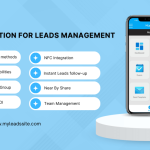An effective lead management system is essential in today’s fast-paced and competitive business environment. Properly managing your leads is crucial for maximizing sales and growing your business. In this blog post, we will discuss the advantages of implementing such a system, its key components, and how it can assist your sales team in achieving their targets.
- Understanding the Concept of Lead Management
Lead management is the process of organizing, tracking, and nurturing leads throughout the sales cycle. A lead management system is a software solution that enables sales teams to capture leads from multiple sources, prioritize them, and automate follow-up activities, ensuring that no potential customer falls through the cracks.
- Advantages of an Effective Lead Management System
Some of the key benefits of implementing this type of system include:
A. Enhanced Efficiency
By automating repetitive tasks, a lead management system allows your sales team to focus on more critical activities, such as closing deals and building relationships with customers.
B. Higher Sales Conversion Rates
The system helps your sales team prioritize leads based on their potential value, ensuring they focus on the most promising opportunities first. This targeted approach increases the likelihood of converting leads into sales.
C. Improved Collaboration
This type of system allows your sales team to easily share information and collaborate on leads, ensuring that everyone is on the same page and working towards the same goals.
D. Stronger Customer Relationships
The system enables your sales team to track and record interactions with leads, providing valuable insights that can be used to personalize future communication and improve customer satisfaction.
- Essential Components of a Lead Management System
A comprehensive system should include the following components:
A. Lead Capture
The software should enable you to capture leads from various sources, such as websites, social media, and email campaigns, and automatically store them in a centralized database.
B. Lead Scoring and Prioritization
A lead scoring feature assigns a value to each lead based on predefined criteria, helping your sales team prioritize their efforts on the most promising leads.
C. Task Automation
A robust system should include features that automate routine tasks, such as sending follow-up emails, setting reminders, and updating lead information.
D. Integration with Other Tools
The system should integrate seamlessly with your existing CRM, marketing automation, and other business tools to ensure smooth data flow and reduce manual data entry.
E. Reporting and Analytics
Your system should provide detailed reports and analytics to help you track the performance of your sales team, measure the effectiveness of your marketing campaigns, and identify areas for improvement.
- Implementing a Lead Management System
To maximize the benefits of this type of system, consider the following steps:
A. Identify Your Needs
Before selecting a lead management system, it’s crucial to define your business’s unique requirements and goals. This will help you choose a solution that best meets your needs and ensures a successful implementation.
B. Train Your Sales Team
Ensure your sales team is well-trained and comfortable using the system. This will increase user adoption and enable your team to get the most out of the software.
C. Monitor Performance and Optimize
Regularly review the performance of your system and make adjustments as needed. This will help you continuously improve your sales process and achieve better results.
Conclusion
In conclusion, implementing a lead management system is an investment in your sales team’s success. By streamlining the process, prioritizing leads, and automating routine tasks, your sales team will be better equipped to focus on what they do best: closing deals and building lasting relationships with customers.












